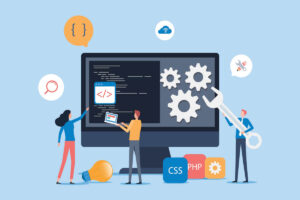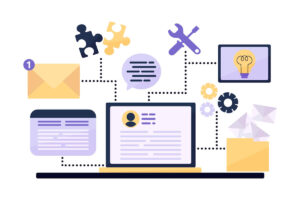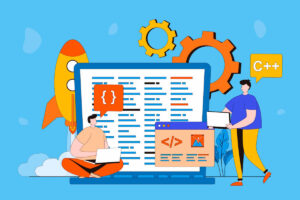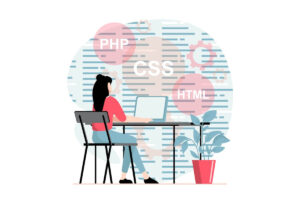Design patterns form the backbone of efficient and scalable software development, particularly in the dynamic world of PHP development. By abstracting common problems into reusable solutions, PHP design patterns empower developers to build applications that are both maintainable and adaptable. This blog post dives into how mastering these patterns can significantly enhance your PHP projects, following a structured approach as outlined in our comprehensive guide.
I. Understanding Design Patterns
Design patterns are standardized solutions to common software design problems. In PHP development, they play a crucial role in enhancing code readability, reusability, and scalability. By leveraging these patterns, developers can solve complex design challenges more efficiently.
- The Role of Design Patterns in PHP Development: In the realm of PHP development, design patterns facilitate the creation of sustainable and manageable codebases. They help in addressing the frequent issues that developers encounter during the development process, making PHP applications more robust and adaptable.
- Types of Design Patterns: There are mainly three categories of design patterns used in PHP development:
- Creational Patterns: Focus on the mechanism of creating objects, aiming to increase flexibility and reuse of existing code.
- Structural Patterns: Deal with the composition of classes or objects to form larger structures, while ensuring the structures remain flexible and efficient.
- Behavioral Patterns: Concerned with efficient communication and the assignment of responsibilities between objects.
II. Creational Patterns in PHP
- Singleton Pattern: This pattern ensures that a class has only one instance and provides a global point of access to it. It’s particularly useful in situations where a single object is needed to coordinate actions across the system.
- Factory Method Pattern: Allows a class to delegate the instantiation process to one or multiple helper subclasses. It is used when a class cannot anticipate the class of objects it needs to create.
- Abstract Factory Pattern: Facilitates the creation of families of related or dependent objects without specifying their concrete classes. This is especially useful in PHP design patterns for developing software with interchangeable or evolveable components.
In the context of PHP design patterns, understanding and applying these creational patterns can significantly improve the structure and quality of PHP applications.
III. Structural Patterns in PHP
- Adapter Pattern: This pattern allows classes with incompatible interfaces to work together. It acts as a bridge between two incompatible interfaces, enabling them to communicate without changing their existing code.
- Composite Pattern: Facilitates the composition of objects into tree structures to represent part-whole hierarchies. This pattern lets clients treat individual objects and compositions of objects uniformly, simplifying the handling of complex structures.
- Proxy Pattern: Involves using a surrogate or placeholder object to control access to another object. This pattern is useful for implementing lazy initialization, access control, logging, monitoring, and securing the real object from unauthorized access.
IV. Behavioral Patterns in PHP
- Observer Pattern: Defines a one-to-many dependency between objects so that when one object changes state, all its dependents are notified and updated automatically. This pattern is foundational for event-driven programming in PHP.
- Strategy Pattern: Allows the behavior of an algorithm to be selected at runtime. By encapsulating algorithms within classes and making them interchangeable, PHP applications can be made more flexible and easier to extend.
- Template Method Pattern: Enables deferring the exact steps of an algorithm to one or multiple subclasses. This pattern provides a skeleton of an algorithm in a method, deferring some steps to subclasses. It lets subclasses redefine certain steps of an algorithm without changing the algorithm’s structure.
Incorporating these structural and behavioral patterns into PHP development can enhance PHP performance optimization and elevate the overall quality of PHP design patterns in applications. These patterns not only streamline development by promoting code reuse and modularity but also ensure that PHP applications are scalable, maintainable, and adaptable to changing business requirements.
V. Implementing Design Patterns in PHP Projects
Implementing design patterns in PHP projects requires a thoughtful approach to enhance code quality and application architecture. Practical tips for integrating design patterns include understanding the problem domain in depth and selecting the most appropriate pattern based on the problem’s characteristics. It’s essential to not force a design pattern where it doesn’t naturally fit, as misuse can lead to code that’s more complex and harder to maintain.
When choosing the right design pattern, consider the size of the project and the team’s familiarity with the pattern. Also, take into account the specific challenges you’re facing. Some patterns are more suited for certain problems. For example, using the Factory pattern for object creation can simplify complex instantiation processes that depend on dynamic conditions.
Common pitfalls in integrating design patterns into PHP projects include overcomplicating designs by applying too many patterns. This can result in using a pattern where a simpler solution would suffice. To avoid these issues, developers should aim for simplicity and refactor incrementally. They should ensure that each pattern applied genuinely solves a specific problem without introducing unnecessary complexity.
VI. Best Practices for Successful Integration
For a successful integration of design patterns in PHP projects, it’s imperative to follow some best practices. These include rigorous documentation of the design and architecture decisions. Documentation should cover why a particular pattern was chosen and how it addresses the specific problem. This not only aids in maintaining the code but also helps in onboarding new team members.
Another key practice is to adhere to the principles of clean code and Refactoring. Even when applying design patterns, the code should remain readable, and its intention clear. Regular code reviews and pair programming sessions can help ensure that the implementation of design patterns adds value without compromising code quality.
Finally, continuous education and adaptation to new and evolving design patterns play a crucial role in maintaining robust and efficient PHP applications. Encouraging a culture of learning and experimentation can lead to innovative solutions and improvements in application design and functionality.
VII. Tools and Resources for PHP Design Patterns
Several resources can significantly aid developers looking to master PHP design patterns. D Online platforms like GitHub and Stack Overflow offer a wealth of examples and discussions on PHP design patterns, making them fantastic resources for practical learning.
PHP frameworks, such as Laravel and Symfony, provide built-in support for various design patterns, making it easier for developers to implement complex patterns in their applications. Libraries such as Doctrine can also facilitate the use of patterns, particularly for data persistence. These tools and resources not only help in understanding PHP design patterns but also in applying them effectively in PHP projects.
Conclusion
Throughout this guide, the importance of PHP design patterns in creating more maintainable, scalable, and efficient applications has been emphasized. By encapsulating proven solutions to common problems, these patterns serve as a toolkit for PHP developers to enhance their coding practices. Continual learning and experimentation with these patterns are key to mastering PHP development. Contact Us to help you harness the full potential of PHP design patterns in your development endeavors.












+ There are no comments
Add yours